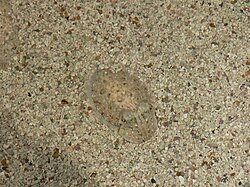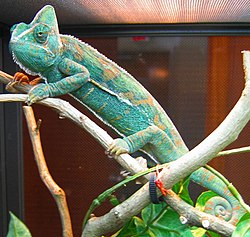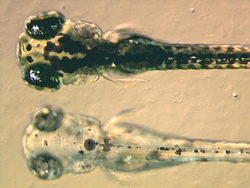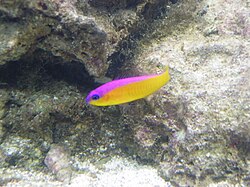Chromatophore

Chromatophores are pigment-containing and light-reflecting cells found in amphibians, fish, reptiles, crustaceans, and cephalopods. They are largely responsible for generating skin and eye color in cold-blooded animals.
Some species can rapidly change color so as to keep in camouflage, or to signal. They do this by moving pigment and reflective plates in chromatophores. This process is called physiological color change. Cephalopods such as octopus have complex chromatophore organs controlled by muscles to achieve this. The display is under central nervous control based usually on input from the eyes.
Vertebrates such as chameleons get a similar effect by cell signalling. Such signals can be hormones or neurotransmitters. They may be started by changes in mood, temperature, stress or visible changes around the animal.
Cephalopod chromatophores

Colleoid cephalopods have complex organs which they use to change color rapidly. This is seen in squid, cuttlefish and octopuses. Each chromatophore unit is a single chromatophore cell and muscle, nerve, glial and sheath cells.[1] Inside the chromatophore cell, pigment granules are in an elastic sac. To change color the animal changes the sac form or size by muscular contraction. This changes its appearance. This differs from the mechanism used in fish, amphibians and reptiles, because the shape of the sac is being changed rather than pigment being moved in the cell. However, a similar effect is achieved.
Octopuses can operate chromatophores in complex, wavelike displays, giving rapidly changing color schemes. The nerves that operate the chromatophores are thought to be positioned in the brain in a pattern similar to that of the chromatophores they each control. This may explain why, as the neurons are activated one after another, the color change occurs in waves.[2]
Like chameleons, cephalopods use color change for social interaction. They are also among the most skilled at camouflage, with the ability to match both the color and the texture of their local environment with remarkable accuracy.
Chromatophore Media
Chromatophores in the skin of a squid
7x speed timelapse video of fish melanophores responding to 200μM adrenaline
A veiled chameleon, Chamaeleo calyptratus. Structural green and blue colours are generated by overlaying chromatophore types to reflect filtered light.
At the bottom a mutant zebrafish larva that fails to synthesise melanin in its melanophores, at the top a non-mutant, wildtype larva
The purple-striped dottyback, Pseudochromis diadema, generates its violet stripe with an unusual type of chromatophore.
Zebrafish chromatophores mediate background adaptation on exposure to dark (top) and light environments (bottom).
Cross-section of a developing vertebrate trunk showing the dorsolateral (red) and ventromedial (blue) routes of chromatoblast migration
References
- ↑ Cloney, RA; Florey, E (1968). "Ultrastructure of cephalopod chromatophore organs". Zeitschrift fur Zellforschung und mikroskopische Anatomie (Vienna, Austria : 1948). 89 (2): 250–80. doi:10.1007/BF00347297. PMID 5700268. S2CID 26566732.
- ↑ Demski, LS (1992). "Chromatophore systems in teleosts and cephalopods: a levels oriented analysis of convergent systems". Brain, Behavior and Evolution. 40 (2–3): 141–56. doi:10.1159/000113909. PMID 1422807.







